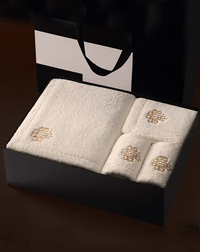Eco-friendly towels are designed with both performance and environmental impact in mind. Here’s what makes a towel sustainable:
1. Organic Materials
Sustainable towels are often made from organic cotton or other natural fibers grown without synthetic pesticides or fertilizers. This reduces the environmental impact of cotton farming and promotes healthier ecosystems.
2. Low-Impact Dyes
Eco-friendly towels use low-impact dyes that require less water and energy during application. These dyes are free from harmful chemicals and help minimize water pollution.
3. Water and Energy Efficiency
Sustainable production practices include efficient water and energy use. Manufacturers employ technologies that recycle water and use less energy, reducing the overall environmental footprint of the production process.
4. Biodegradable or Recycled Fibers
Some eco-friendly towels incorporate recycled fibers or biodegradable materials, reducing waste and promoting circular economy principles. These towels break down naturally at the end of their lifecycle or are made from recycled content, reducing the need for new raw materials.
5. Sustainable Manufacturing Practices
Green manufacturing practices, such as reducing waste and minimizing chemical use, contribute to the sustainability of towel production. Manufacturers focus on reducing their environmental impact through responsible production methods.
6. Certification and Transparency
Look for certifications like OEKO-TEX® or Global Organic Textile Standard (GOTS), which ensure that towels meet stringent environmental and ethical standards. Transparency in sourcing and production processes also indicates a commitment to sustainability.
By focusing on these factors, eco-friendly towels offer a sustainable choice that combines quality and environmental responsibility.




















